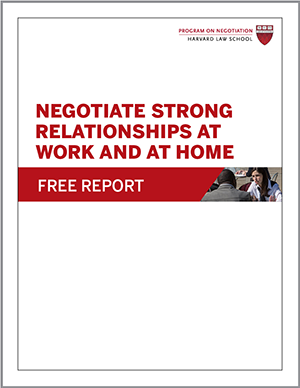
A married couple was debating whether their four-year-old daughter should attend public or private elementary school. It was a difficult issue, and Mike had a tendency to walk out when the conversation got heated. Frustrated, Lisa turned to negotiating terms and conditions just as a negotiator would in a business deal. Alternative dispute resolution (ADR) techniques helped them to come to an agreement.
Lisa imposed a condition on the negotiation itself: she would discuss the issue only if Mike agreed not to flee. Mike readily consented to this reasonable request.
When the discussion inevitably became tense again, he remembered his promise and stayed at the table. Thanks to the condition that Lisa had added to the negotiation, they reached a deal: public school at the outset but revisiting the issue each year as needed.
Alternative Dispute Resolution (ADR) Techniques
Expert negotiators are familiar with the benefits (and limits) of contingent contracts—deal clauses that assist negotiators in resolving disputes by “betting” on their different predictions. Imagine, for example, that a buyer and a seller are negotiating over pricing for delivery services, which will depend heavily on the future price of gas. Believing that gas prices will increase, the seller demands a high price for the service contract. The buyer, who believes gas prices will fall, wants to pay a low price today. If both sides genuinely believe their forecasts, they can set a low price, but with a contingency: the buyer must make added payments if the price of gas rises.
A condition to a deal is a related though far less common deal-structuring technique. Like a contingency, a condition is an “if” statement (“I’ll discuss our daughter’s schooling only if you promise to stay at the table”). But whereas a contingency depends on unknown future events, such as the price of gas, a condition is entirely within the control of the parties involved.
In addition, conditions are resolved during talks—and no later than the closing of the deal. Specifically, negotiating terms and conditions can help you to not only avoid impasse but also to create value and claim value.
Lisa’s condition established a ground rule for her negotiation with Mike. Such “process” conditions can be as useful in business deals as in personal ones. Recently, a couple was interested in buying a vacation house on Martha’s Vineyard, an island off the coast of Massachusetts. They found their ideal retreat and submitted a bid, only to learn that the seller had just received another offer.
The seller suggested an auction between the two bidders. The couple agreed, but only under the following conditions: (1) a single-round, sealed-bid auction, with the seller bound in advance to accept the higher offer; and (2) offers had to include a specific dollar amount (rather than, say, “One dollar more than the higher offer”).
The seller could either reject the couple’s conditions and be left with only one bidder or accept the ultimatum and achieve a one-round auction. The seller accepted the conditions, and the couple won the property at what they perceived to be a reasonable price, thanks to conditions that avoided an all-out bidding war.
Your entry into a negotiation often carries its own value. Lisa, naturally, needed Mike at the table for them to resolve the issue of their daughter’s schooling. Similarly, the couple’s bid on the vacation home was valuable to the seller seeking an auction. When your entry has such value, don’t give it away. Instead, propose ADR negotiating conditions that extract process terms to your advantage.
What are your favorite alternative dispute resolution (ADR) techniques? Share them in the comments.
Adapted from “Negotiate Conditions—and Bring Value to the Deal” by Guhan Subramanian, first published in the April 2007 issue of the Negotiation Briefings newsletter.
Originally published in 2010.





